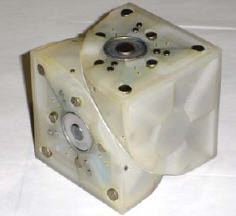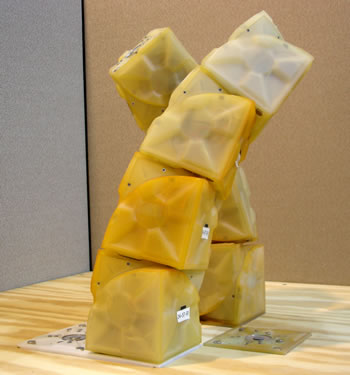Science Fiction
Dictionary
A B C D E F G H I J K L M N O P Q R S T U V W X Y Z
Self-Replicating Modular Robots

Hod Lipson, Victor Zykov, Efstathios Mytilinaios and Bryant Adams have been working on machines that replicate themselves. Their strategy is to use small modules that attach to each other with electromagnets.

(From Self-Replicating Machine Module)
Each ten centimeter cube is an autonomous unit with a microprocessor and a set of instructions on how to link themselves with other modules.
For example, four blocks piled up on top of each other to form a tower can create another identical tower by swiveling around and picking up other blocks and piling them up. Obviously, much larger and more complex structures can be built by expanding on this model.

(From Self-Replicating Machine Pictures)
The self-reproducing machines demonstrate here are essentially modular robots, composed of multiple identical actuated modules with electromagnets to selectively weaken and strengthen connections so as to determine where the structure breaks and joins. Each module is a 10cm cube, split into two halves... One half of the cube can swivel relative to another half in increments of 120°, each time cycling three faces of the cube. Connected cubes can thus form and reconfigure into arbitrary morphologies... The cubes are powered at the base and transfer data and power through their faces. The control of the machine is distributed among the modules: A microcontroller onboard each module executes a motion schedule governed by time and contact events.
(From Self-reproducing Machines pdf)
John von Neumann was the first scientist to do rigorous work on the topic of self-replicating machines. However, science fiction author Philip K. Dick beat him to the punch with his 1955 short story Autofac, which described an automated factory that also had the capacity to reproduce itself by shooting tiny pellets full of nanomachines into the distance:
"They're building," O'Neill said, awed. He got up and prowled on. Off to the side, at the far edge of the gully, he came across a downed pellet far advanced on its construction...This one had made great enough progress to be identified. Minute as it was, the structure was familiar. The machinery was building a miniature replica of the demolished factory.
(Read more about Philip K. Dick's autofac)
I'd also add a reference to a more structured version of this idea, the Robot Cells (Crystal-Shaped Modules) from 1987 work by Michael P. Kube-McDowell.
The concepts explored by these simple modules may also have applications on other planets:
Self-replication could have major implications for how robots are used in remote environments where repairing them is difficult. "Self-replication is the ultimate form of repair," Lipson says. "You can imagine robotic systems on Mars or at the ocean bottom repairing themselves using a mechanism like this."
Read more about how autonomous modular machines might be used on other planets in TETWalker: Shape-Shifting Robot Swarm. See the Cornell Self-Replication website and the article at New Scientist . Thanks to Trevor Curran for the tip on this story.
Scroll down for more stories in the same category. (Story submitted 5/11/2005)
Follow this kind of news @Technovelgy.| Email | RSS | Blog It | Stumble | del.icio.us | Digg | Reddit |
Would
you like to contribute a story tip?
It's easy:
Get the URL of the story, and the related sf author, and add
it here.
Comment/Join discussion ( 3 )
Related News Stories - (" Robotics ")
Artificial Skin For Robots Is Coming Right Along
'... an elastic, tinted material that had all the feel and appearance of human flesh and epidermis.' - Harl Vincent (1934)
Robot Guard Dog On Duty
I might also be thinking of K-9 from Doctor Who.
Wearable Artificial Fabric Muscles
'It is remarkable that the long leverages of their machines are in most cases actuated by a sort of sham musculature...' HG Wells, 1898.
Dancing Robots Taught Dance Moves
'A clockwork figure would be the thing for you...' Jerome K. Jerome, 1893.
Technovelgy (that's tech-novel-gee!) is devoted to the creative science inventions and ideas of sf authors. Look for the Invention Category that interests you, the Glossary, the Invention Timeline, or see what's New.
Science Fiction
Timeline
1600-1899
1900-1939
1940's 1950's
1960's 1970's
1980's 1990's
2000's 2010's
Current News
The Zapata Air Scooter Would Be Great In A Science Fiction Story
'Betty's slapdash style.'
Thermostabilized Wet Meat Product (NASA Prototype)
There are no orbiting Michelin stars. Yet.
Could Crystal Batteries Generate Power For Centuries?
'Power could be compressed thus into an inch-square cube of what looked like blue-white ice'
India Ponders Always-On Smartphone Location Tracking
'It is necessary... for your own protection.'
Amazon Will Send You Heinlein's Knockdown Cabin
'It's so light that you can set it up in five minutes by yourself...'
Is It Time To Forbid Human Driving?
'Heavy penalties... were to be applied to any one found driving manually-controlled machines.'
Replace The Smartphone With A Connected Edge Node For AI Inference
'Buy a Little Dingbat... electropen, wrist watch, pocketphone, pocket radio, billfold ... all in one.'
Artificial Skin For Robots Is Coming Right Along
'... an elastic, tinted material that had all the feel and appearance of human flesh and epidermis.'
Robot Guard Dog On Duty
I might also be thinking of K-9 from Doctor Who.
Wearable Artificial Fabric Muscles
'It is remarkable that the long leverages of their machines are in most cases actuated by a sort of sham musculature...'
BrainBridge Concept Transplant Of Human Head Proposed
'Briquet’s head seemed to think that to find and attach a new body to her head was as easy as to fit and sew a new dress.'
Google's Nano Banana Pro Presents Handwritten Math Solutions
'...copy was turned out in a charming and entirely feminine handwriting.'
Edible Meat-Like Fungus Like Barbara Hambly's Slunch?
'It was almost unheard of for slunch to spread that fast...'
Sunday Robotics 'Memo' Bot Has Unique Training Glove
'He then started hand movements of definite pattern...'
Woman Marries Computer, Vonnegut's Dream Comes True
'Men are made of protoplasm... Lasts forever.'
Natural Gait With Prosthetic Connected To Nervous System
'The leg was to function, in a way, as a servo-mechanism operated by Larry’s brain...'
